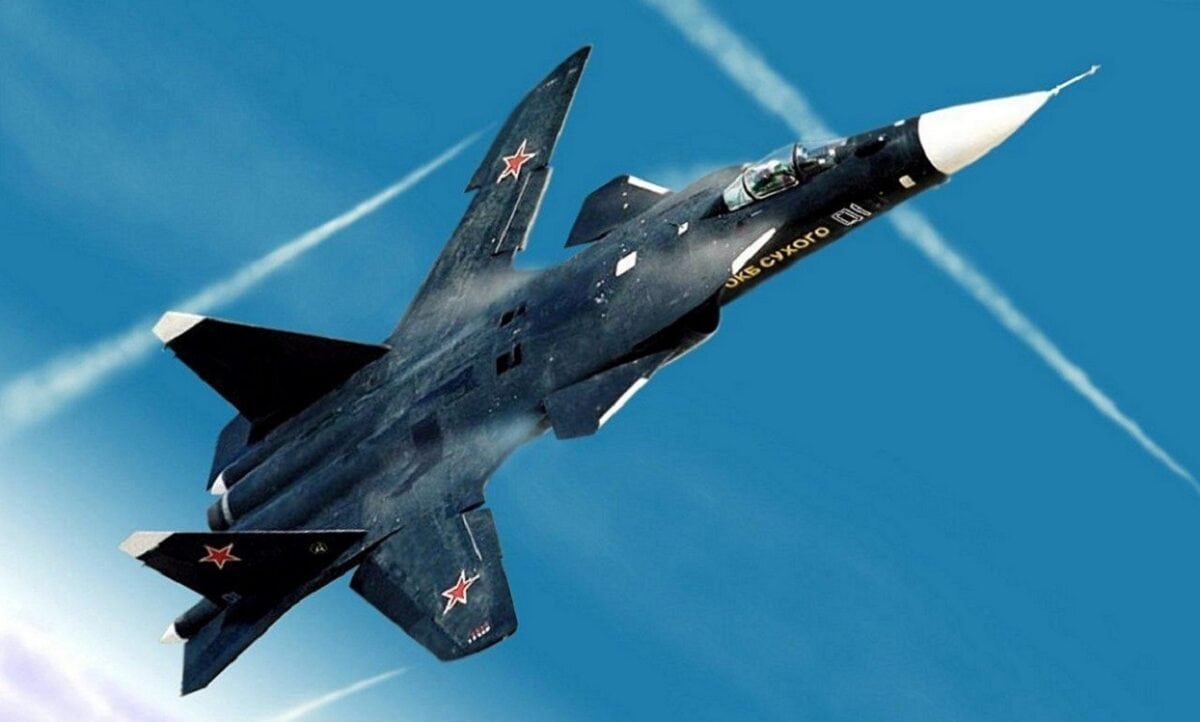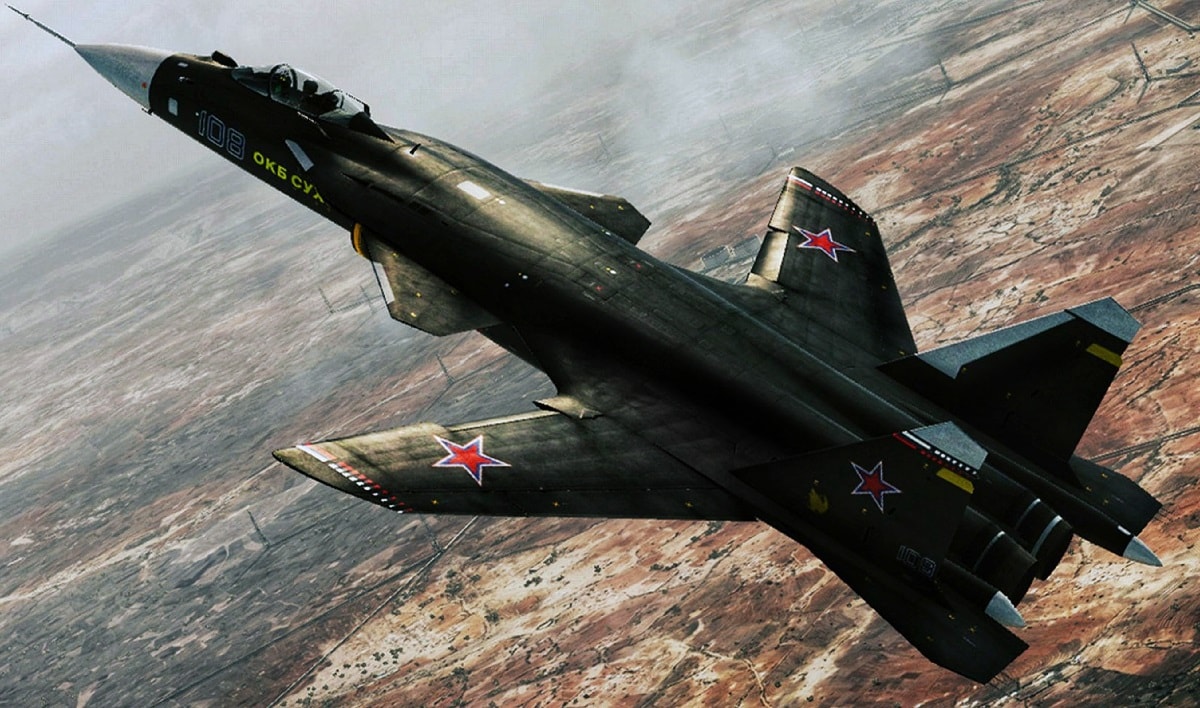During the Cold War, the Soviet Union attempted to build a number of weapons hoping to have an edge over the western military industry. Many of these weapon platforms, however, never reached the production stage.
1st Combat Deployment! Russian Su-57 Stealth Fighter Jets Spotted Over Northern Ukraine Before Crucial Peace Talks
One such piece of military equipment was the Su-47 ‘Berkut’ fighter jet. Only one aircraft was produced which is widely described as a predecessor of Russia’s 5th-generation Su-57 (Felon) stealth fighter jet.
In 1996, a photo of a meeting between Russian military officials and aviation industry peers was published in the March/April issue of the Air Fleet Bulletin. This photograph drew considerable interest for another reason: two fighter jets were placed on the table.
One was a more advanced version of the Flanker multi-role fighter, which was already well-known at the time. The other was an unusual black jet with forward-swept wings — that is, wings swept in the wrong direction.

At the time, this second fighter plane attracted a lot of attention among Western defense experts. While it’s unclear if the image was leaked accidentally or deliberately, it triggered a flurry of speculation in the Western and Russian press.
The reason for all the excitement was that the F-22 production model made its first flight the same year, and this new advanced jet was quickly deemed to outshine the F-22 Raptor stealth fighter. This new fighter jet model was a Sukhoi Su-47 Berkut (“Golden Eagle”), a high-tech prototype.
Lessons From Ukraine – Russian Invasion Offers Key Insights To Taiwan To Repeal Possible Chinese Attack
Unconventional Design
During the Cold War, the USSR and the US developed a good number of weapons to counter each other. To confront America’s Advanced Tactical Fighter program, which gave birth to the F-22 Raptor, the Soviet Union planned a fifth-generation fighter.
At the same time, the Soviet Navy was looking for a new fighter with good low-speed handling characteristics to fly from the Ulyanovsk, a supercarrier with steam catapults, that was cast aside in Ukraine in 1988.
The project of the development of Su-47 was originally conceived in the 1980s. Sukhoi decided to research the possibility of Forward Swept Wings (FSW).
Theoretically, this concept allows for greater maneuverability, especially at low speeds and high angles of attack, enhanced spin resistance, shorter take-off distances, and increased range by reducing air resistance.

The Western press speculated that Russia was developing a stealth jet. Sukhoi proposed that the Berkut would have an internal weapons compartment that could accept four long-range R-77 air-to-air missiles (then still in development), as well as four external short-range R-73 missiles. However, Sukhoi later admitted that the Su-47 was not designed with stealth in mind.
According to Airforce Technology, the Su-47 possessed a high lift-to-drag ratio, 9g capability, enhanced stall resistance, and added stability at high-angles of attack, despite its slower speed than the Su-57.
The fighter jet, which was known by several designations such as the S-22, Su-27KM, S-37, and finally the Su-47 at various stages, also had adjustable canards, the second set of small wings adjacent to the cockpit to improve maneuverability and lift.
The aircraft was equipped with the two D-30F-11 turbojet engines, which were identical to those found on the powerful MiG-31 Foxhound interceptor. However, more advanced AL-41F thrust-vectoring turbofans were intended to eventually replace them. The S-37, like the F-16, was so agile that it relied on a fly-by-wire technology to rectify its aerodynamically unstable features automatically.

The aircraft’s excellent low-speed handling made it a strong contender for a carrier-based fighter. The Ulyanovsk and the Navy’s requirement for a replacement carrier-fighter were both canceled after the Soviet Union fell apart in 1991. The manufacturer, on the other hand, funded this project on its own to develop one demonstrator model.
What Went Wrong?
Forward-swept wings, however, have major drawbacks. The flying dynamics of aircraft with forward-swept wings are extremely unstable. The wings themselves are subjected to a great deal of stress, especially at high speeds. The wings must bend without breaking due to high-stress loads. This is quite a difficult task for the engineers.
The Su-47 would have limited G-loads as the weight of weapons would have added 18-ton to the aircraft. And this would have proven incredibly expensive to maintain.

Furthermore, while it had incredible quick turning performance, it struggled to maintain speed in extended corners.
While the fighter’s projected speed was Mach 2, the fastest speed reported by Berkut was Mach 1.65. Only one Su-47 appeared at airshows from time to time, raising apprehension that the manufacturer was not too confident about the product.
Nevertheless, Berkut was responsible for the development of various technologies that helped make the Su-57 ‘Felon’.
The American X-29
The United States also considered using forward-swept wings. The Defense Advanced Research Projects Agency even built a technology demonstrator that resembles the Su-47. Called the X-29, the aircraft is billed as the most aerodynamically unstable airplane ever created, according to DARPA.
The technology utilized in the development of the X-29, like those employed in the Su-47, pushed the boundaries of what was practicable.

Some of the technology from the X-29 was subsequently employed in the development of future platforms. According to a DARPA statement, “advanced composite materials are now extensively used in military and commercial aircraft.”
While the Berkut and X-29 were never produced for operational deployment, they did act as an important test-bed for new technologies.
- Contact the author at ashishmichel@gmail.com
- Follow EurAsian Times on Google News




